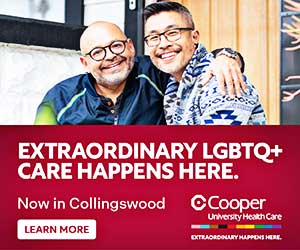The New England Journal of Medicine last week carried a report from a group of researchers from Fox Chase Cancer Center that found that some clinical trials exclude gays and lesbians.
According to the report, initiated by FCCC biostatistician Brian Egleston, about 15 percent of trials that focus on erectile dysfunction, hypoactive sexual desire disorder or couples therapy contained eligibility requirements that participants must be heterosexual.
“What we suspect is that since these types of trials relate to sexual functioning or couples studies, researchers might think that gays and lesbians are inherently different when it comes to sexual functioning or relationships than heterosexuals,” Egleston said.
He noted that the impact is more widespread than it appears on the surface.
“What we found is that these studies tend to be ones that are very large, industry-sponsored Phase III trials, so they’re being run at 80 sites, 50 sites, 20 sites all over,” he said. “Even though it’s only 15 percent, it’s a group that is very large.”
Egleston’s interest in this issue was piqued last year when he came across trials that had been proposed at FCCC and that explicitly excluded LGBTs. He did an initial search on ClinicalTrials.gov, which tracks all trials funded by the National Institutes of Health, government agencies and private companies, and noticed the exclusionary language was used in a number of studies.
Egleston said it appeared that the eligibility language was often copied from other studies, signaling that the issue may stem from a lack of forethought rather than a desire to discriminate.
Egleston enlisted fellow FCCC researchers Roland Dunbrack and Michael Hall to conduct a more widespread analysis of ClinicalTrials.gov, and said the PGN story about their efforts last fall helped fuel support.
“Our press office picked up the story and put it in their weekly media report and that was sent to everyone in the center,” he said. “So we had a couple-thousand people getting the e-mail in which the Philadelphia Gay News was mentioned, and most of them had probably never even heard of the paper, but they were able to find out about the research and a lot of people came up to me and gave me their support. And once the e-mail went out, it paved the way for the center itself to provide us with the support we needed to write this article.”
The three researchers found that, of the 234 studies included in the three focus areas, 37 contained exclusionary language. To ensure that no patterns were overlooked, researchers also looked at more than 1,000 studies about asthma and found none that excluded gays and lesbians.
Since last week, the story has been picked up by an array of LGBT news sites, as well as mainstream papers such as the New York Times.
“It’s too bad this issue had to be brought up, but it’s definitely interesting to see the results,” Egleston said. “I think people have definitely taken notice and we’re getting responses from NIH researchers who are explaining their positions, and I even saw some pharmaceutical companies issuing official responses to reporters, which is really exciting.”
Egleston said he hopes his research serves as a “wake-up call” for companies that are needlessly excluding LGBT individuals.
“If researchers have a choice in what measure they use to study outcomes, such as if they’re studying erectile dysfunction or sexual functioning in women, they should be using measures that would be appropriate for both heterosexuals and gay and lesbian couples,” he said. “I think the most important part of this is looking to the future. The past is the past and, in the future, I hope people will try to design more inclusionary studies.”
Jen Colletta can be reached at [email protected].
